Distinguish between Web3 social platforms Lens and Farcaster from the perspectives of protocol layer design, ecological applications, and developer communities
Original Title: ROWS #4: Decentralized social media part. 2 - Lens and Farcaster
Original Author: Albivers
Original Compiler: Lynn, MarsBit
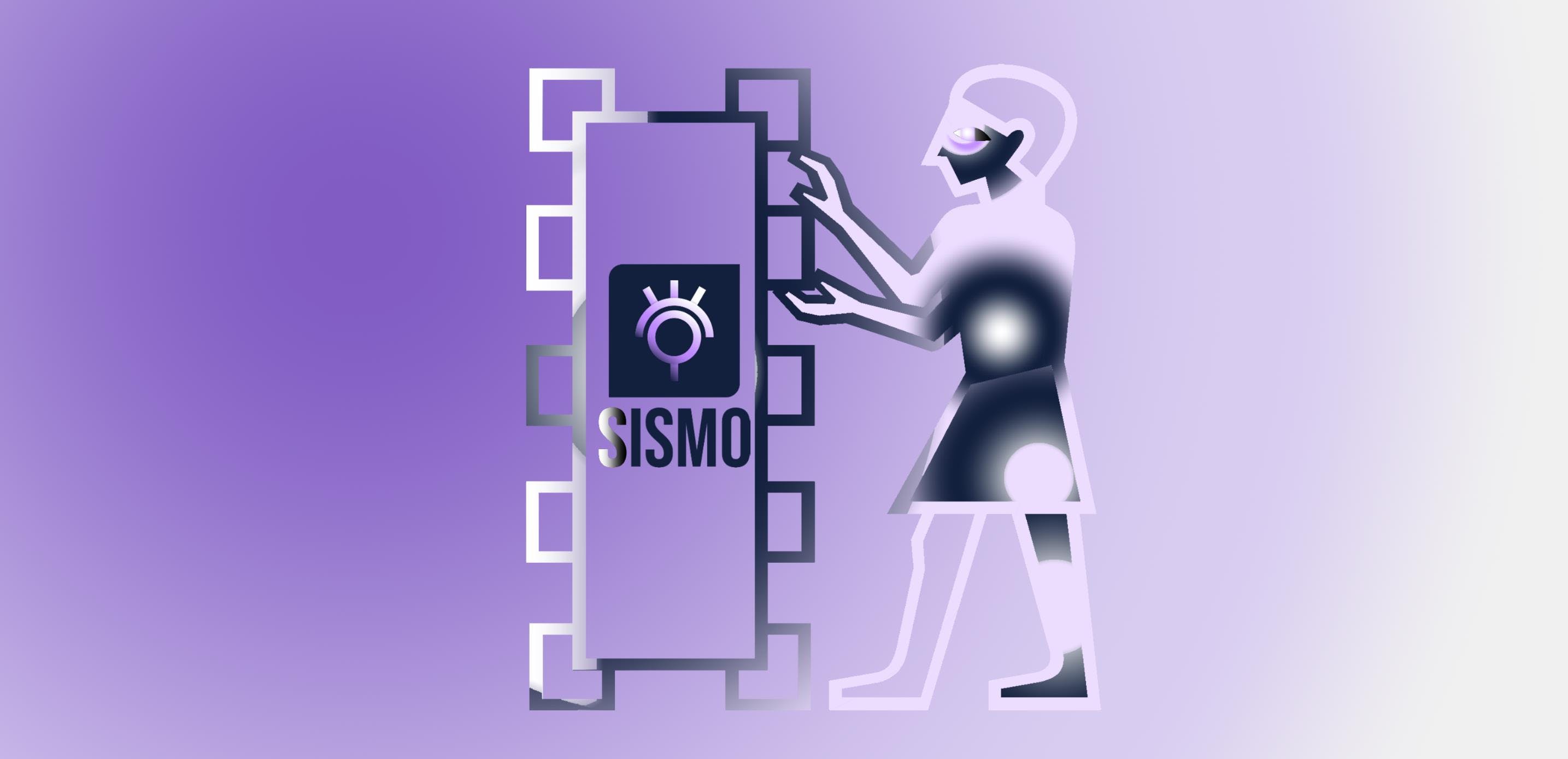 Welcome back to the "Rise of Web3 Social" series. In today's article, I will share my findings on the Lens and Farcaster ecosystems.
Welcome back to the "Rise of Web3 Social" series. In today's article, I will share my findings on the Lens and Farcaster ecosystems.
I will analyze these two ecosystems based on the methods introduced in the next section and share my perspectives throughout the article.
Three Components of Successful Web3 Social Protocols
 I have structured this analysis around the three main components of web3 protocols:
I have structured this analysis around the three main components of web3 protocols:
First, the protocol itself.
- This includes the functionality and architecture of the protocol.
- Success can be measured by the number of builders and creators who use the protocol to create things.
- It depends on the quality of the protocol, such as the relevance, usability, scalability, and interoperability of the features provided by the protocol (for more on this, see Issue #2). Builders tend to appreciate how responsive the core team is to their needs.
Second, the project ecosystem developed using the protocol.
- This consists of applications, clients, and middleware tools built on top of the protocol.
- Success can be measured by the number and quality of products, communities, and creators actively operating on top of the protocol.
- It depends on the experience of developers, the trusted neutrality of the protocol, and the availability of resources in the form of capital and talent. What truly helps builders is an existing social graph, a wealth of content, good development tools, and collaboration with other builders.
Finally, the community that powers this ecosystem.
- This is a network of creators, builders, investors, and consumers. Initially, the focus may be on bringing in a developer community, but I believe there is no right order to guide this multi-sided "market."
- Success here can be measured by the number and capabilities of individuals, the strength of their relationships, the frequency of their interactions, whether they meet in real life, support each other, and whether they integrate each other's applications in cases of significant synergy.
- It depends on the core team's ability to formulate and execute a cohesive strategy.
Lens Protocol, Applications, and Community
Lens was born from the Aave ecosystem and core team, embodying a web3-native culture rooted in DeFi.
- Protocol ------ On-chain and "asset-first"
On one hand, the Lens protocol was initially designed so that all attention and published content is recorded on-chain in the form of NFTs, forming an on-chain social graph.
By tokenizing content and profiles, one could say Lens is an "asset-first" social media (created by the Variant Fund team). This allows Lens social media assets such as profiles and content to be collected, traded, and combined with other parts of the Ethereum ecosystem. This leverages the unique properties of blockchain. For example, people can use some valuable content as collateral for loans to fund new creations.
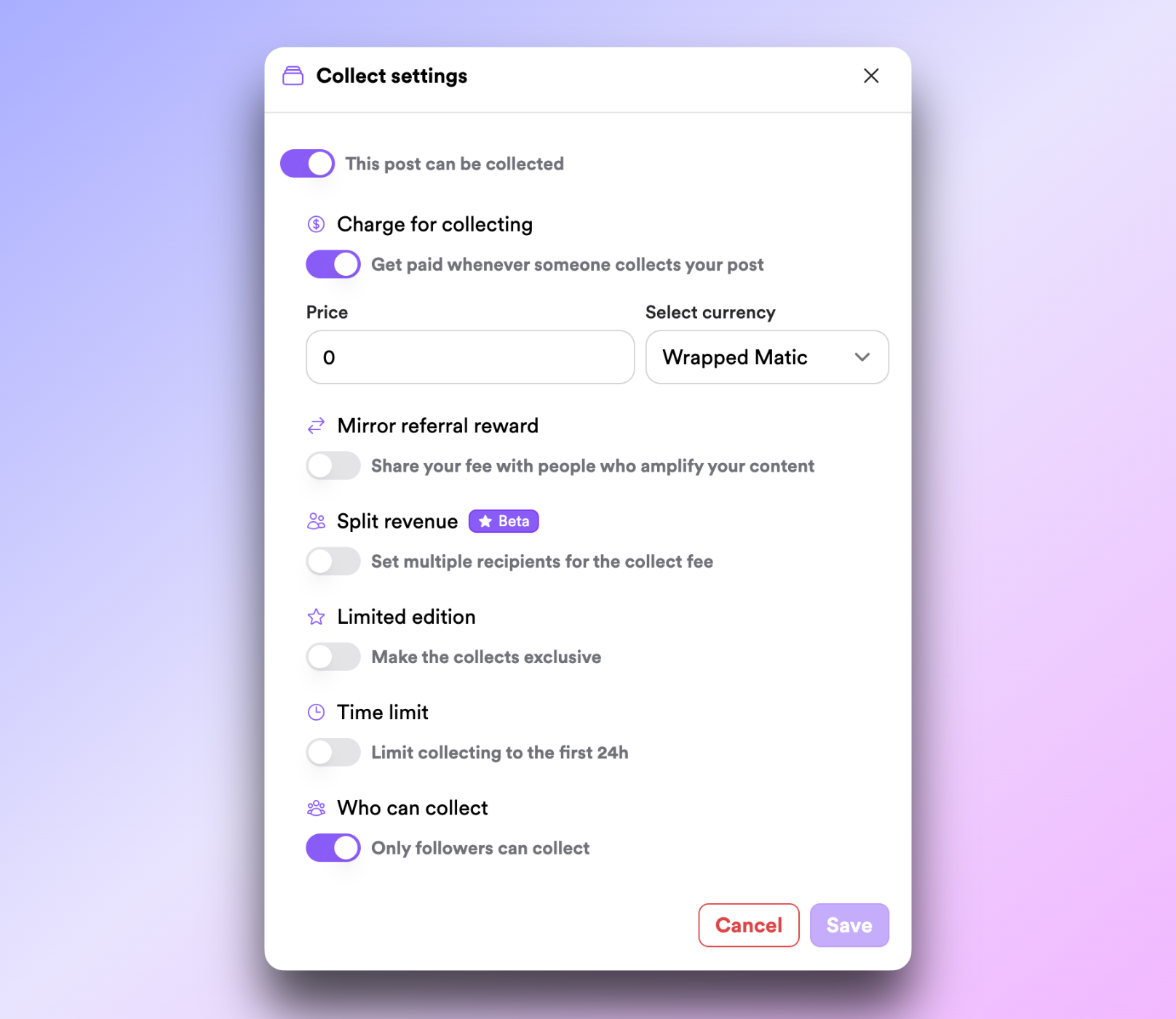 Creators can set their posts as collectible and add collection conditions
Creators can set their posts as collectible and add collection conditions
Another example of on-chain power is the MadFinance application, which allows brands and influencers to conduct business around sponsored posts directly on-chain without intermediaries. Brands set bounties for the posts they want to see and place the money into an escrow contract. The creator then creates a post, signs it, and submits it for brand review. If the brand is satisfied, it can verify the post, which will be automatically published, and the creator will be compensated.
Given that most activities on Lens are recorded on-chain, it is possible to achieve clearer and more systematic value distribution through smart contracts. For example, multiple stakeholders in the social media value chain, such as customer builders, referrers, promoters, and creators, may receive a share of the fees from end-users purchasing NFTs. In the web2 paradigm, value distribution is often opaque, and many stakeholder groups do not even get compensated for their work.
In addition, the Lens team will soon release LensV2, which includes concepts like Open Actions and ERC-6551 ProfileNFT that will further enhance Lens's advantages in composability. Open Actions allow builders and creators to directly embed other web3 applications into the source of the Lens client (e.g., hey.xyz). For example, I could allow my followers to collect Lens posts to gain access to join a collective on party.app in a single social media post. ERC-6551 ProfileNFT is the direct owner of all data it publishes, and when combined with avatars developed by Sonar, a company acquired by the Lens team aimed at enhancing profiles, it could yield interesting use cases. It can also be transferred to another wallet.
 Airstack founder Jason Goldberg comments on the power of Open Actions
Airstack founder Jason Goldberg comments on the power of Open Actions
However, the advantages mentioned earlier are merely speculative, and the future of the protocol remains to be seen after the release of LensV2. Moreover, the "asset-first" and highly on-chain nature may have some significant downsides.
It is difficult to predict the behaviors that will emerge with the financialization of all social media assets (such as our own profiles)! Imagine an open market for Twitter/X accounts. Imagine all TikTok posts being collectible and tradable. This could lead to healthy speculation but also to negative behaviors such as fleeting cash grabs and scams. I also believe that while monetization is a superpower for creators, financialization is not the fun that most people seek on social media.
Additionally, Lens has faced some scalability issues in the past, with high costs per user. This is the price of heavily tokenizing all publications on Polygon. The team has been seeking to alleviate this by shifting social activities from publications to off-chain, moving to a new optimistic Layer 3 called Momoka, and tokenizing publications only when necessary. For non-technical people like me, whether this design can scale to millions of daily active users remains an open question.
Last but not least, as security giga Brain @Oops explained, the current design of ProfileNFT allows individuals to seize and impersonate handles without any mechanism to manage handles and protect other users from bad actors. Stani actually suggested that Oops should submit a proposal to change this at the protocol level.
 My curated list of top Lens concepts. This list is not exhaustive. Visit the Lens documentation at https://docs.lens.xyz/v2/docs/what-is-lens.
My curated list of top Lens concepts. This list is not exhaustive. Visit the Lens documentation at https://docs.lens.xyz/v2/docs/what-is-lens.
A brief overview of the current state of Lens protocol governance and revenue model.
Lens Governance: Currently, Lens is being tested in a closed environment, with the core team controlling everything. They are slowly opening up, allowing the community to propose improvements through Lens improvement proposals under a model similar to EIP.
Funding and Business Model: Lens has raised over $17 million from companies like IDEO and General Catalyst. It is unclear how they will sustain themselves in the future, but they may adopt a fee model, like Zora and Mirror, taking a portion of the value flowing from somewhere on their platform.
*
#### Lens Project Ecosystem - Attempting On-Chain Media
Here is a non-exhaustive overview of the current ecosystem of applications and tools built on Lens.
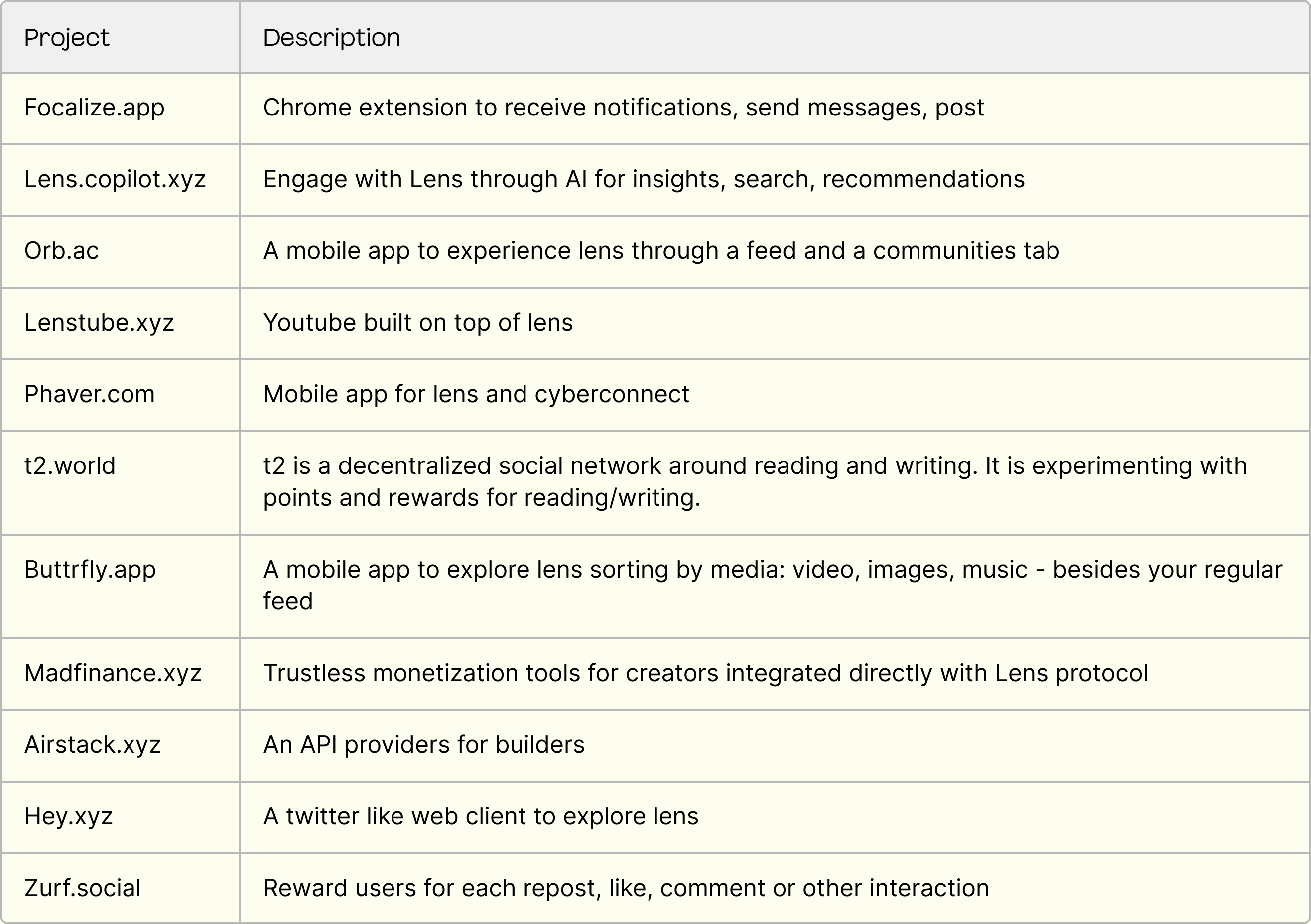 Usage of different applications and clients over the past few months according to Zurf.social.
Usage of different applications and clients over the past few months according to Zurf.social.
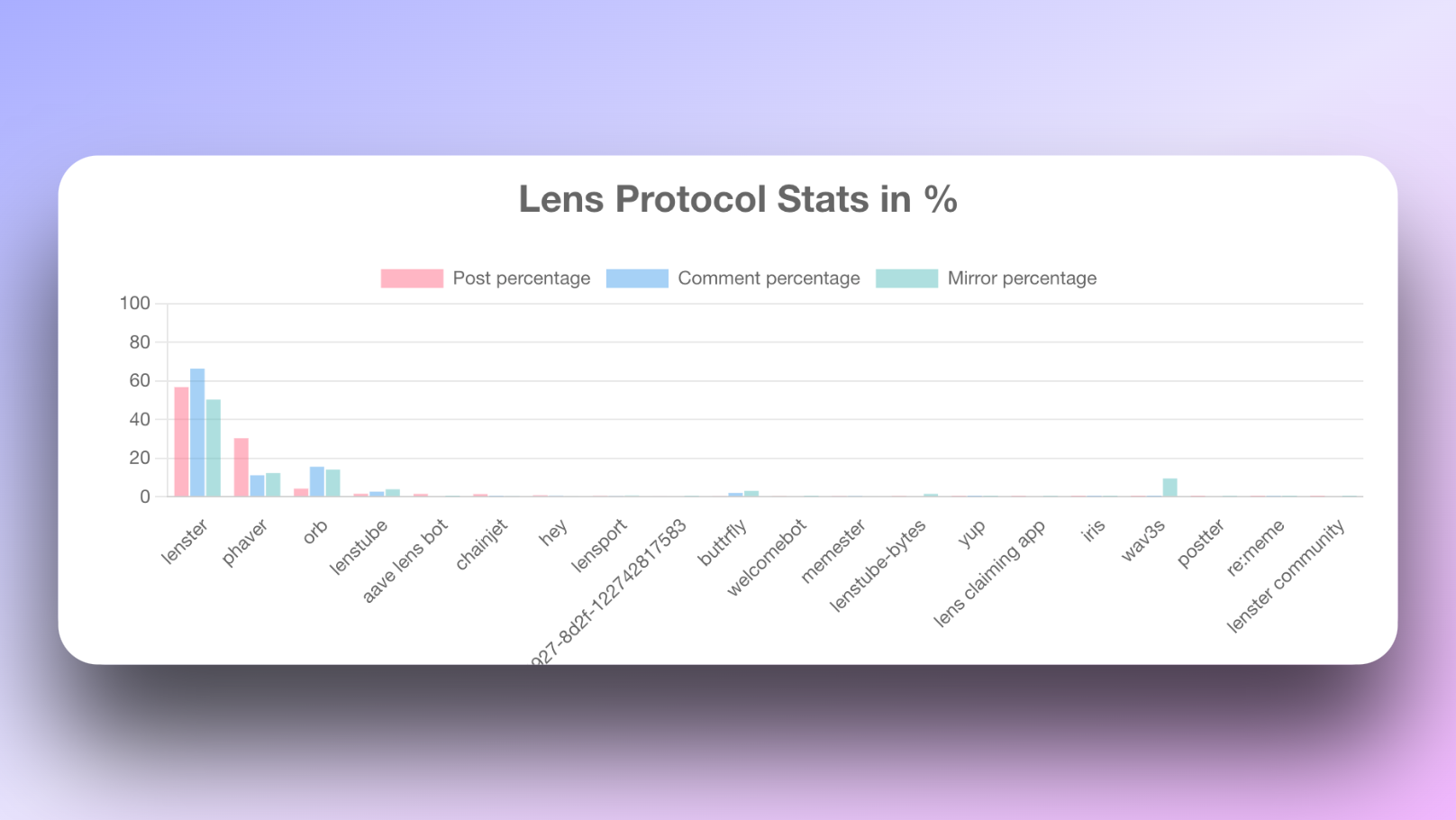 Post, comment, and mirror statistics on Zurf.social from April 10 to October 10
Post, comment, and mirror statistics on Zurf.social from April 10 to October 10
The three largest applications in the Lens ecosystem are clients with social media feeds. According to the chart, Hey.xyz (formerly known as Lenster), a Twitter-like client created during the Lens hackathon in March 2022, now holds a significant market share. Phaver, which recently raised $7 million, ranks second, followed closely by Orb, which recently raised $2.3 million.
The experience on Hey and Orb is very similar to Twitter/X, except for the ability to set posts as gated or collectible, while Phaver allows people to stake each other's posts to curate them and earn rewards when they happen to have good taste.
These observations were made before the launch of Open Actions, which will allow more complex applications to be embedded into the feeds. The deployment of LensV2 may trigger a wave of innovative features and enthusiasm within the Lens ecosystem.
Airstack positions itself as a leading web3 social data provider and API (including Farcaster and Lens).
*
#### Lens Community - Still Searching for Healthy Growth Sources
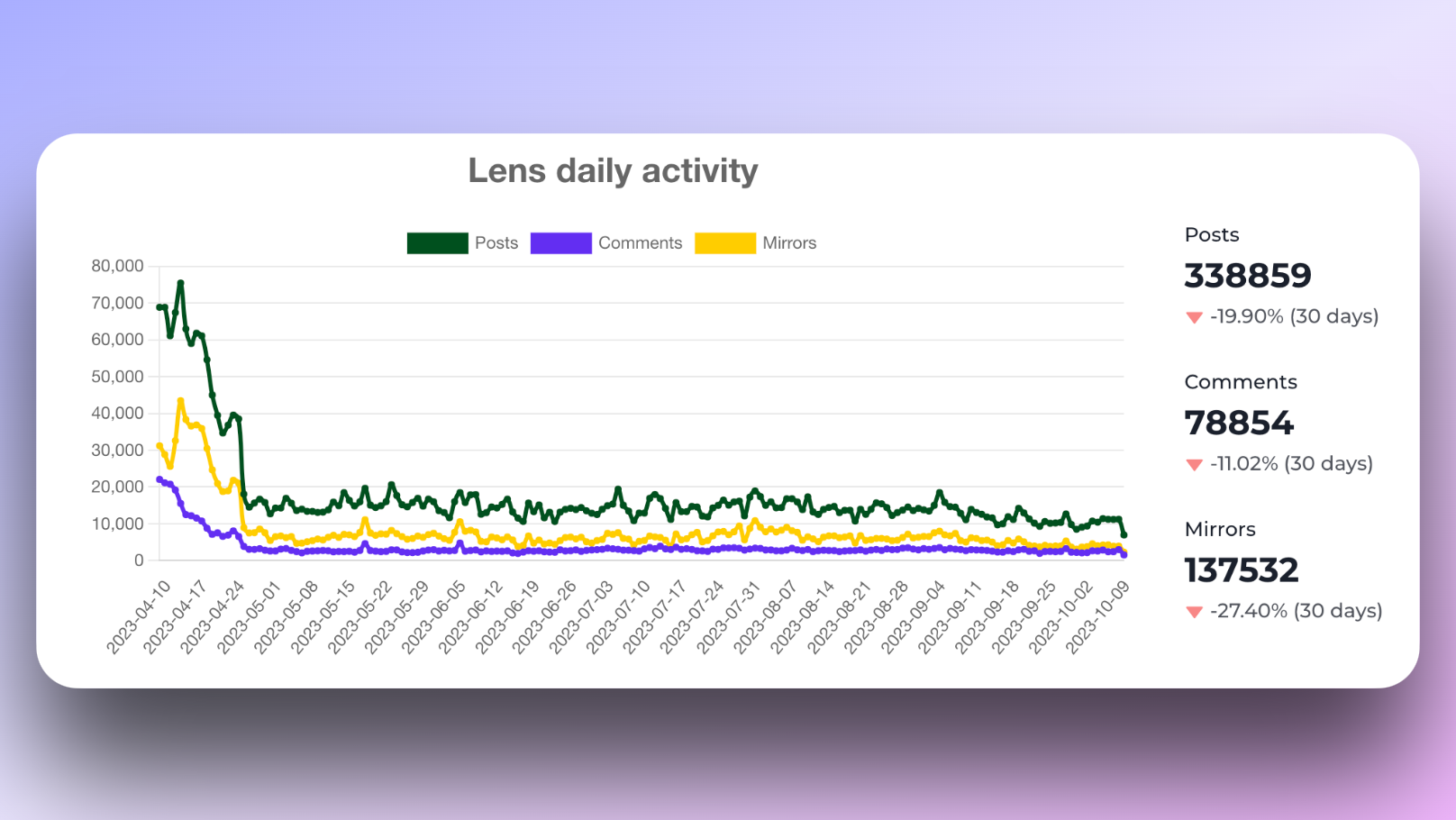 Lens daily activity statistics source: Zurf.social - https://hey.xyz/posts/0xe222-0x032f
Lens daily activity statistics source: Zurf.social - https://hey.xyz/posts/0xe222-0x032f
Today, Lens is still in a closed phase, with only over 100,000 people able to access Lens handles.
Lens has encountered some bot issues, and it is actively working to address these through the use of AI, internal testing, and other potential methods I am unaware of. The reduction in the number of bots on the platform may partially explain the decline in activity over the past few months, but this cannot be confirmed 100%.
To my knowledge, the Lens team has been focusing on both developers and creators for growth. This is to guide the supply of applications and services as well as valuable content, which is the lifeblood of all social platforms.
Content on Lens is often primarily created by regular users or web3 creators, which starkly contrasts with the developer-heavy community of Farcasters. Some examples of creators include Jessyfries.lens, ChaoticMonk.lens, Grams.lens, thefaketomato.lens.
The "developer community" tab/channel on the Orb App (similar to Twitter community groups) has 500 members. It is only moderately active but may be the best place to get Lens updates and ask questions to other developers.
Overall, the Lens community is still in its early stages, and I have not observed a reliable community flywheel in place.
Farcaster: Decentralized Social Made in Silicon Valley
Farcaster was founded by Dan Romero and Varun Srinivasan in Silicon Valley, both of whom previously held senior positions at Coinbase.
*
#### Protocol Layer ------ Pragmatic Decentralization
The cultural roots of the founders are reflected in the elegant architectural choices of the protocol and a pragmatic philosophy about decentralization, which their CTO refers to as "sufficient decentralization." It states that two users in a far-reaching network should always be able to communicate with each other, which means:
- They own their identity
- They can publish and read network messages in an uncensored manner
Let's see how this is accomplished.
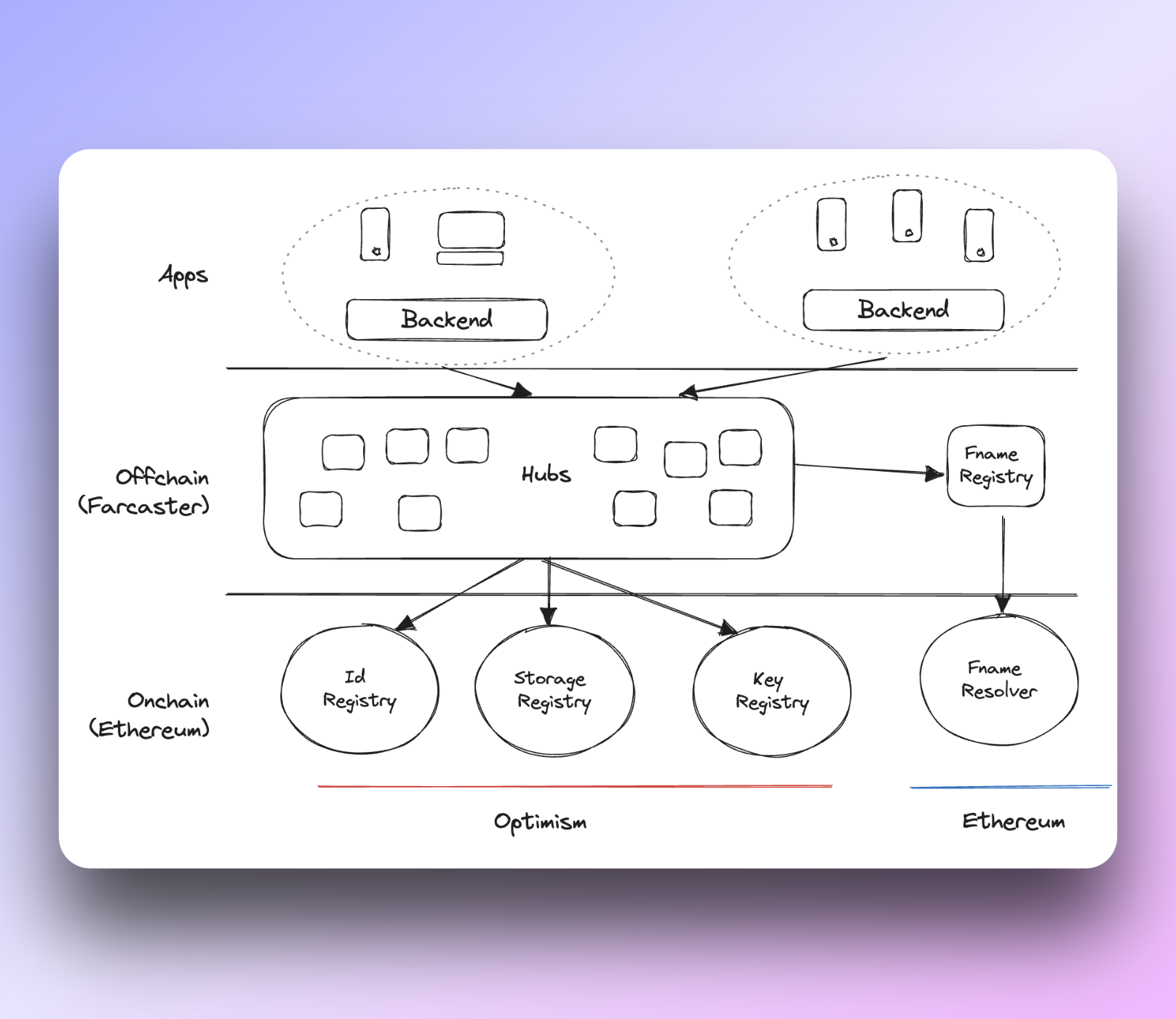 Farcaster architecture described at https://docs.farcaster.xyz/protocol/architecture.html
Farcaster architecture described at https://docs.farcaster.xyz/protocol/architecture.html
At a higher level, user identities are recorded and owned on-chain, while messages and posts are stored in a network of off-chain nodes called Hubs, which can process events faster and store user data more cheaply compared to a fully on-chain solution. In many ways, we can say that Lens is moving towards a more off-chain approach with its new L3 Momoka.
However, Farcaster currently does not offer any new sexy on-chain features at the protocol level (think Lens Open Actions, collecting…). Instead, the FC team focuses on creating a robust set of more traditional social media features for posting, reposting, commenting, etc. Therefore, for me, an open question is whether this partially off-chain and conservative protocol design will limit FC's ability to be a good environment for developers to unleash their creativity.
One thing that may mitigate this "downside" is the emergence of third-party services already in the Farcaster ecosystem:
- Indexers and data providers like Airstack and Neynar bypass the need for an on-chain social graph
- Tools like Mint can compensate for the lack of post system tokenization
- SDKs like Discove can replace Open Actions, allowing developers to create mini-applications directly within Warpcast
One thing is for sure, there is currently no way to collect posts, transaction data, and other social assets on Farcaster.
When it comes to developer experience, the only thing I can say is that I have heard some good news from developers in the FC community. The simplicity of Farcaster is an advantage in an already complex environment.
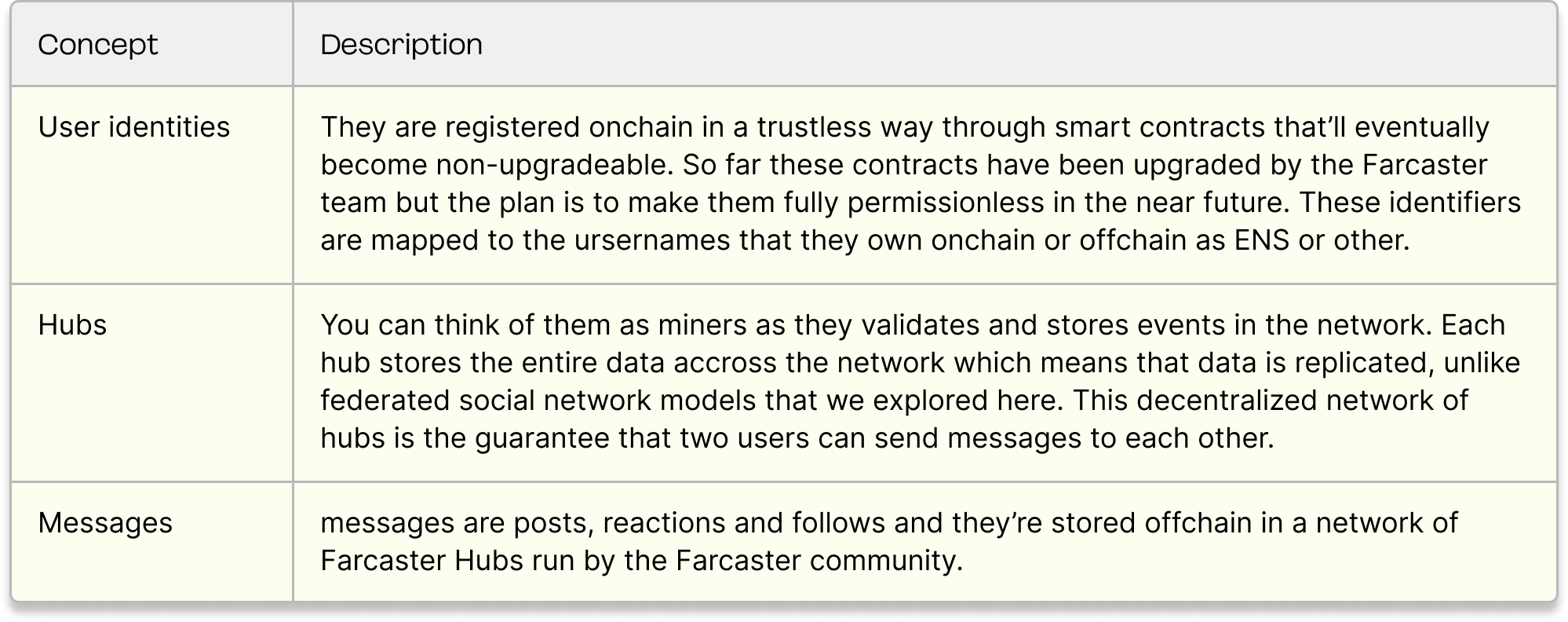 Several key concepts in the Farcaster protocol
Several key concepts in the Farcaster protocol
FC's Business Model: Users will pay a yearly fee to the center to store their data. This is handled by storage contracts, with prices depending on supply and demand.
FC's Governance: "Farcaster adopts rough consensus and running code as its governance model. Changes occur when someone proposes a suggestion, gains support, and publishes running code."
*
#### Clients and Applications - Developers Unleashing Their Creativity
Here is a non-exhaustive list of projects built by the Farcaster community.
 A non-exhaustive list of projects based on Farcaster
A non-exhaustive list of projects based on Farcaster
Warpcast is the main client for Farcaster today, holding over 90% market share. It is built by the Farcaster team itself and is the most comprehensive product in the entire FC ecosystem. The FC team is building the Warpcast client alongside the Farcaster protocol and intends to leave the maintenance of the protocol to the community in the long run.
One of the advantages here is having a high-quality client that everyone can use as an entry point into the FC community. Another is that the team can experiment with new features while developing the protocol.
On the other hand, a major downside is that this may undermine the incentive alignment between the core team (also developing the protocol) and other projects competing for users, especially considering Warpcast's massive market share and first-mover advantage. For this reason, Warpcast may still remain the protagonist in the Farcaster ecosystem and become a super application, somewhat like Twitter when it runs third-party applications around it, but more powerful.
This article can support the categorization of projects in the FC ecosystem into two types:
- Projects enhancing the Warpcast application: A series of projects focused on enhancing Warpcast's functionality: Eventcaster for creating events, Searchaster and Findcaster for searching posts or people, Launcaster for discovering projects, Discove for embedding mini-applications in the Warpcast feed, and Weponder for creating polls on Warpcast, etc. Making Warpcast a kind of super application.
- Loosely integrated projects with Farcaster that extract specific types of data: For example, Fabric.xyz displays Farcaster profiles with checkmarks on its platform. Unlone posts live text records as topics on Warpcast. Paragraph has directly integrated the FC social graph and comments into its web3 publishing platform. In this category, founders see themselves as members of the FC community and start integrating with Farcaster before adding other protocols.
It will be interesting to see which of these categories thrives in the coming year.
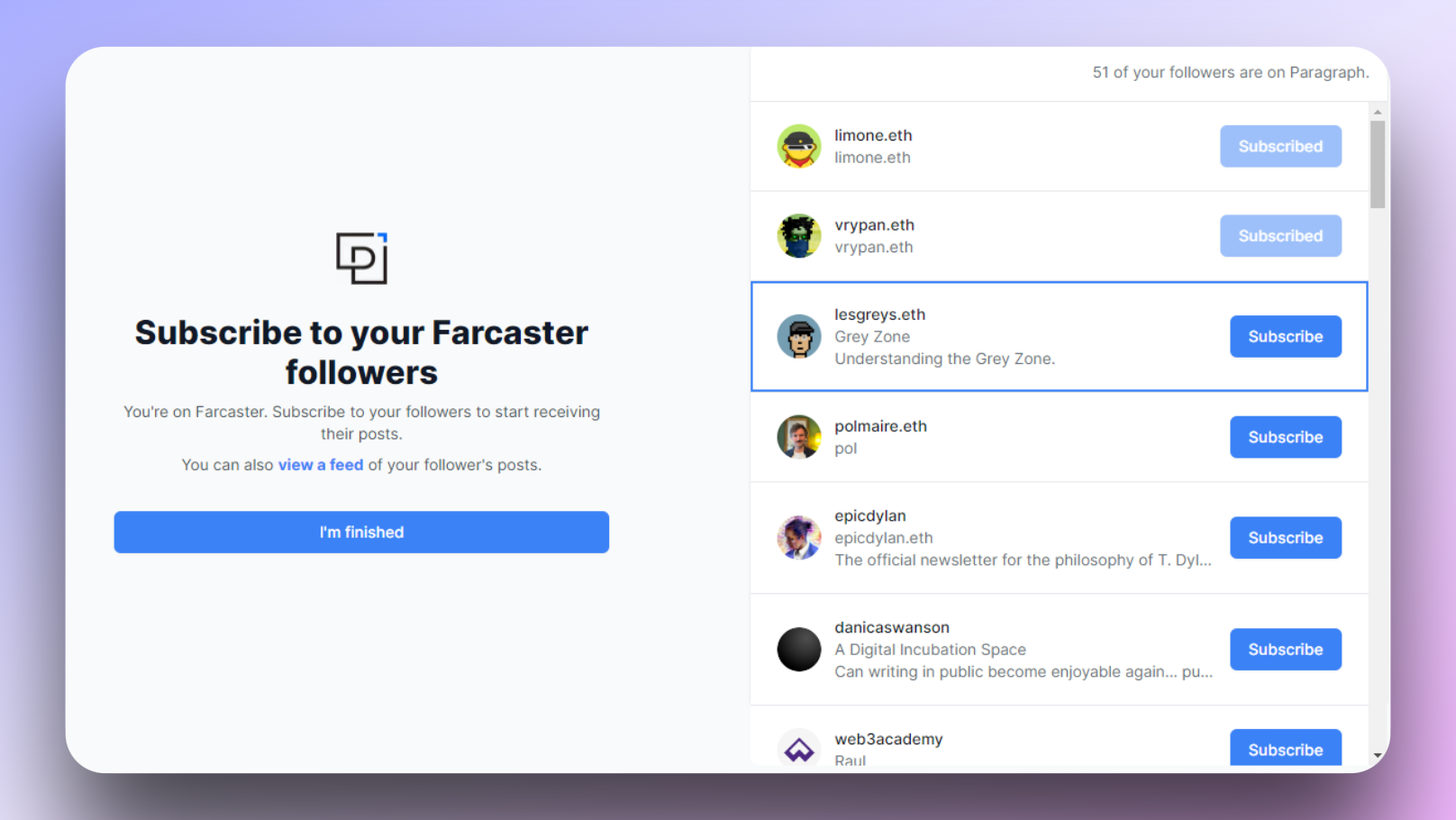 Paragraph onboarding process suggests subscribing to your FC followers
Paragraph onboarding process suggests subscribing to your FC followers
*
#### Community Level - Slow and Cohesive Growth Before Opening
Please note that today is October 10, 2023, and Farcaster has opened to the public. This may bring significant changes to community dynamics.
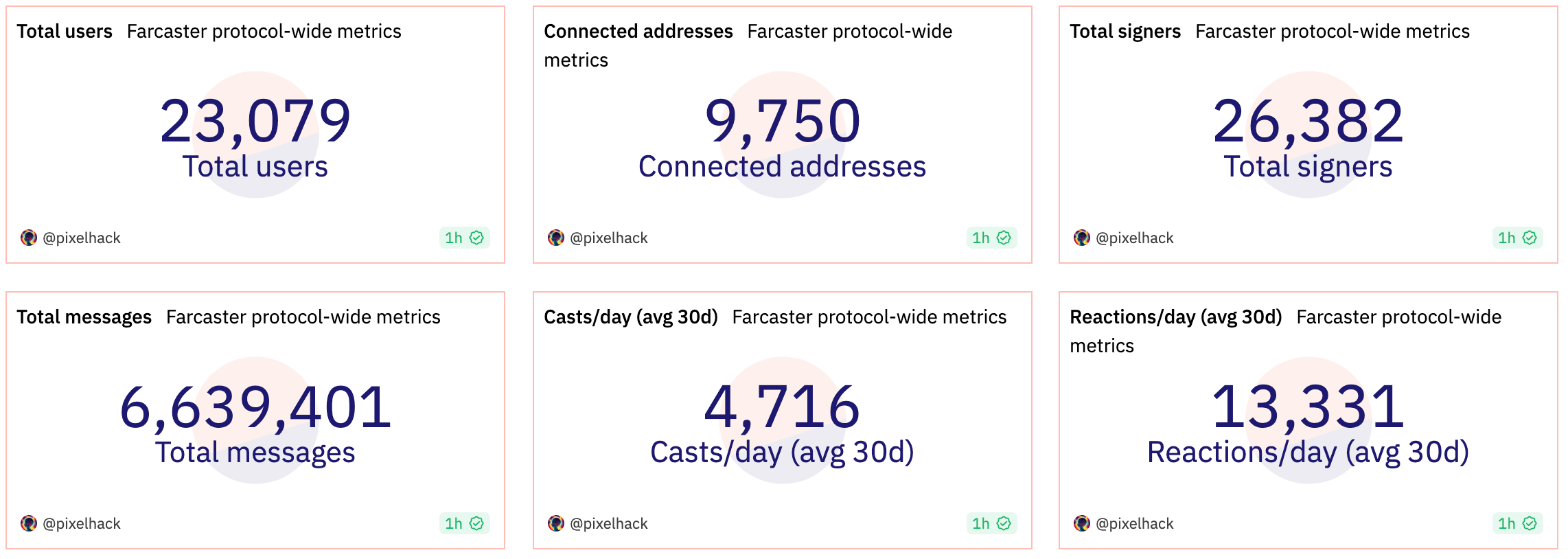 Lens metrics as of October 12, 2023 - https://dune.com/pixelhack/farcaster
Lens metrics as of October 12, 2023 - https://dune.com/pixelhack/farcaster
The Farcaster community is very tightly knit. The early community was born during the last cryptocurrency crash, which I would describe as a group of "smart optimistic builders." It is developer and founder-led, with some creating content and live streaming on unlonely, but I have not seen any complete creators.
Developers often go out to play and enjoy sharing new experiments with each other. The current application ecosystem reflects this, with many single-person passion projects. Developers tell me that the community feels welcoming, and social incentives truly reward those builders who dare to create.
Until today, Dan Romero has been the primary source of onboarding for Farcaster, with user invitations coming in second. This gradual manual onboarding has two benefits: it slowly solidifies community culture and prevents bots from entering the platform, thus maintaining cohesion and quality in dialogue and content.
Some members are indeed very engaged, as seen from their follower counts. Most of them have far fewer followers on Twitter. Some have raised their hands and become leaders of the kind channels on Farcaster (choosing feeds that include various topics). A few truly active users account for most of the conversational fluidity on the platform.
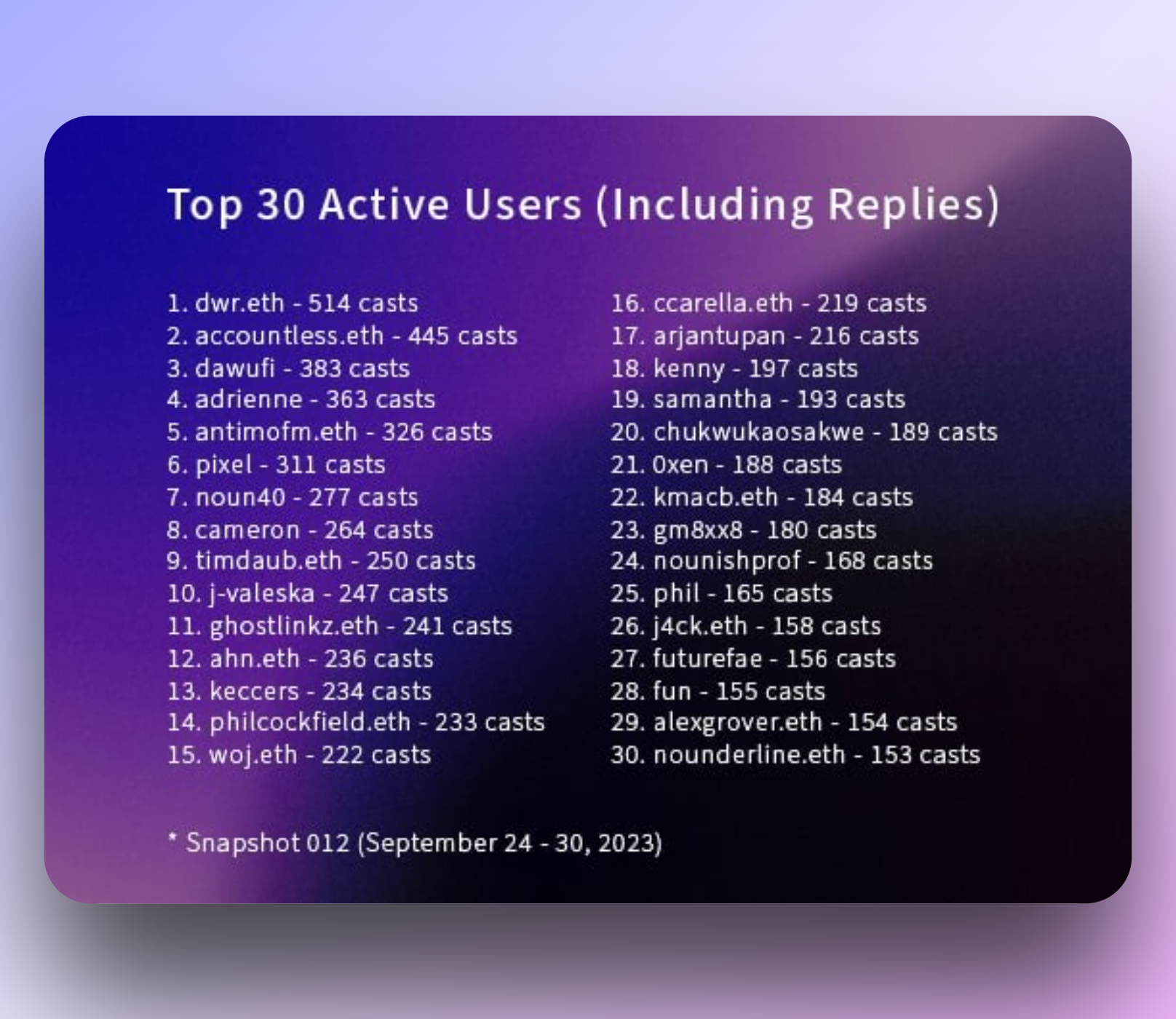 https://warpcast.com/ccarella.eth/0xa4bd4f
https://warpcast.com/ccarella.eth/0xa4bd4f
What will happen now that Farcaster is open is an open question. It should face the same issues regarding bots and spam that Lens has encountered. And its initial community may also lose the quality of being a trusted and comfortable space.
Research continues…
Thank you for reading!
It is clear that Lens and Farcaster are designed very differently. While I have more theoretical interest in the composability and web3-ness offered by the Lens protocol, I admire the achievements of the Warpcast team in building the protocol, client, and community simultaneously, and they have achieved significant success so far.
Will LensV2 bring a new wave of innovation to the Lens ecosystem? Will Warpcast continue to rise and dominate the Farcaster ecosystem? Let's check back on these questions in a few months.
I will add the FC and Lens projects to the map I first shared in Issue #1, and as we explore the identity layer of web3 in Issue #5, we will keep a close eye on these two protocols.
Resources
- Lens Dune Dashboard
- Farcaster Documentation
- Lens V2 Developer Steptember Call for Development
- Article explaining Farcaster identity and data methods
- Farcaster vs Lens by Author: Daniel Lombraña
- Detailed article on Farcaster by LJW and Cameron Armstrong: Farcaster Protocol First
- LensV2 Documentation
- Varun's Sufficient Decentralization
- Founders of the Farcaster Community and Their Projects









